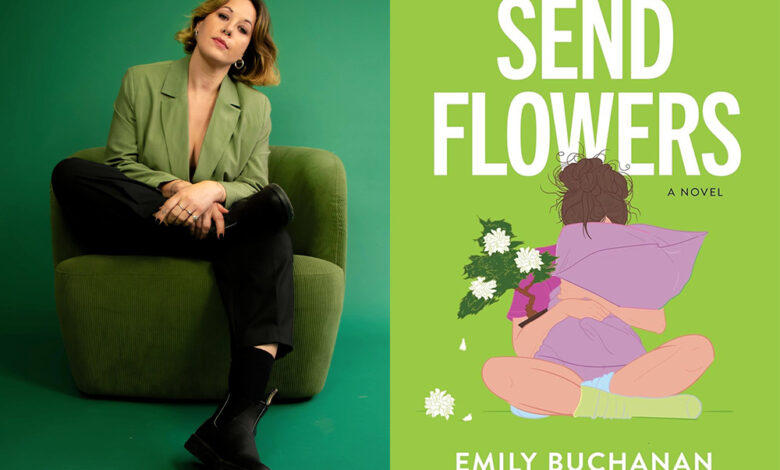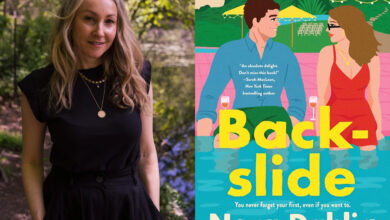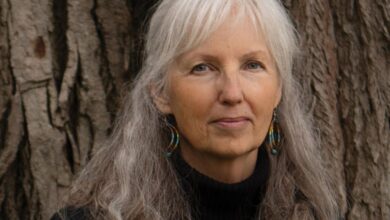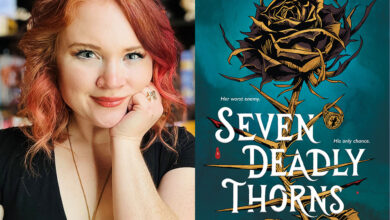Q&A: Emily Buchanan, Author of ‘Send Flowers’

We chat with author Emily Buchanan about Send Flowers, which is a heartfelt debut about a “greenfluencer” who becomes convinced that her late boyfriend has been reincarnated as a houseplant, perfect for fans of Margo’s Got Money Troubles and Remarkably Bright Creatures.
Hi, Emily! Can you tell our readers a bit about yourself?
I’m an author and activist living in Norwich, England, with my composer spouse and a herd of four-legged friends. I originally grew up on the Kent coast, where I’d write bedtime stories for my little sister in the hopes of being a ‘proper’ writer one day. I’ve worked in environmental campaigning for over ten years, chiefly with Greenpeace, and have participated in my fair share of climate activism. I’m happiest swimming in a river, growing flowers or getting lost in a forest with my dog.
When did you first discover your love for writing and stories?
As I say, it’s something I’ve done since I was a child. My little sister is five years younger than me so when I was twelve I took it upon myself to write a story that I’d read to her at bedtime. We used to brainstorm the plot together and then I’d go away and write one chapter a week (I found the file on an old USB and it’s over forty thousand words!). After that, I wrote stories throughout my adolescence. They were always derivative of what I was reading at the time, from The Lion The Witch And The Wardrobe to Angus, Thongs and Perfect Snogging, but a sign that I wasn’t content just reading stories, I needed to write them.
Quick lightning round! Tell us:
- The first book you ever remember reading: The Whales’ Song by Dyan Sheldon
- The one that made you want to become an author: The Illustrated Mum by Jacqueline Wilson
- The one that you can’t stop thinking about: I’ll never get over Homegoing by Yaa Gyasi
Your debut novel, Send Flowers, is out now! If you could only describe it in five words, what would they be?
Funny, furious, weird, empowering, moving
What can readers expect?
SEND FLOWERS draws you in with an unusual proposition: what if someone thought a houseplant was the reincarnation of their dead boyfriend? It weaves magical realism with speculative world building to explore grief – both for lost love and our ailing planet. It traverses London to the furthest reaches of Scotland and all the way back again, following lapsed climate activist turned eco-influencer Fifi, who in the depths of grief becomes convinced that her boyfriend has returned as a flowering tree. Following his floral cues, she reconnects with friends, family and the natural world, and ultimately rediscovers her purpose.
Early readers have called it funny and heartbreaking, hopeful and damning. It’s a novel that explores both the highs and lows of the human condition, with an overriding message that change is possible when people refuse to give in.
Where did the inspiration for Send Flowers come from?
The idea came to me six and half years ago when I was signed off work with an autoimmune disease. I was too sick to care for my houseplants and they started dying. I was feeling deeply sorry for myself and realised that if I went, my plants would go with me. I was living in London at the time during a mega heatwave and working for Greenpeace, so I started thinking about houseplants as mechanisms to tolerate climate change – like by hoarding houseplants, we’re trying to capture something of the rainforest when the world around us is being depleted. I’d also experienced a family bereavement a few years prior so, given that I wasn’t working and had time to process all these thoughts, a character started to emerge – a houseplant boyfriend, no less.
Were there any moments or characters you really enjoyed writing or exploring?
I loved writing the cast of supporting characters. They each respond to climate change in their own way and this helped me shape their personalities. There’s Tracy, Fifi’s mum, who’s in denial and has slipped into the world of conspiracy theories. There’s her dad, John, who’s moved to a remote island in West Scotland to build his own personal utopia. There’s Beth, her best friend, and Beth’s girlfriend Celeste, who are both climate activists and prepared to go to any lengths to save the world. There’s Ed, Fifi’s late boyfriend, who was similarly committed but whose convictions made him unreasonable and elitist. Then there’s Fifi, who’s trapped in the middle. She cares deeply about the planet but she’s not the sort of person to glue herself to buildings or lay down in front of traffic. She has to navigate these different approaches to activism and figure out how to take a stand in a way that remains authentic to her strengths and her vulnerabilities.
Did you face any challenges whilst writing? How did you overcome them?
The biggest challenge, as I’m sure all writers can relate to, was self belief. Writing a novel takes full-hearted commitment to a single story, so having faith that my story deserved to be told, and seeing it through to the finish line, took a huge amount of willpower. Before I had an agent or a book deal, there was no one to motivate me but myself – every deadline was self imposed. The creative process can be such a bully. I either felt like I was writing the Next Big Thing or a total fraud, so riding that rollercoaster without letting it dampen my resolve was incredibly tough at times.
This is your debut novel! What was the road to becoming a published author like for you?
It’s taken a hot minute – the best part of a decade, actually! I’m not the most disciplined writer (especially before I got representation) so the pace has been slow. Plus, I felt for the majority of the process like I was in a pitch black tunnel, feeling my way through to the finish line with very little in the way of expertise. But following my initiation has really paid off – despite the many crises of confidence I’ve had along the way! I feel so fortunate to have found such a fantastic agent in Hayley Steed, and incredibly proud to be published by Park Row, who have rallied behind the message of SEND FLOWERS and helped me elevate it in such a beautiful way.
What’s next for you?
I’m writing book two as we speak! It’s thematically similar to SEND FLOWERS but set in the past, so a very different experience in terms of process and voice. I’m really enjoying getting stuck into research – I just got a subscription to newspapers.com and am trawling through archives, immersing myself in a whole other world and grasping the social history. I’ve also been travelling around the UK to get a sense of location, so it’s been a fascinating process so far and I can’t wait to apply all that I’ve learned writing SEND FLOWERS to my second novel.
Lastly, what books have you enjoyed reading this year? Are there any you’re looking forward to picking up?
The best book I’ve read this year is Sorrow And Bliss by Meg Mason – it really speaks to my own experience of mental illness and I found it so propulsive. I also loved Dark Earth by Rebecca Stott. It’s set in AD500 in the ruins of Londinium – the Roman town that became the city of London – and gave me that eerie but curious feeling of exploring abandoned places.
Reading has taken a bit of a back seat to SEND FLOWERS this year, so there are hundreds of books on my TBR. I’m really excited to read Pat Barker’s new book, The Voyage Home, as I loved The Silence of the Girls, and I’m yet to read Coco Mellors’ Blue Sisters, after devouring Cleopatra and Frankenstein.
Will you be picking up Send Flowers? Tell us in the comments below!
Source link




